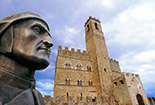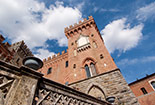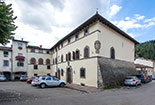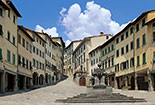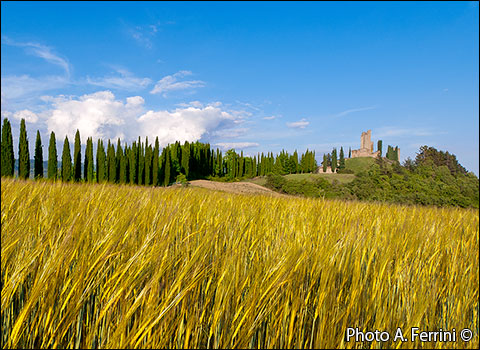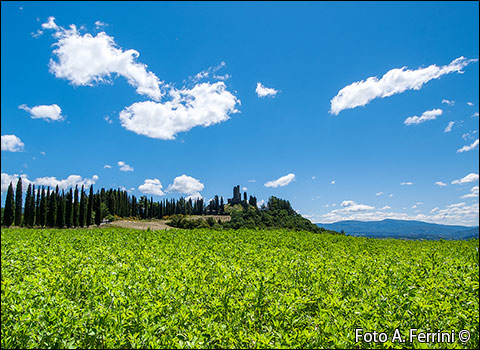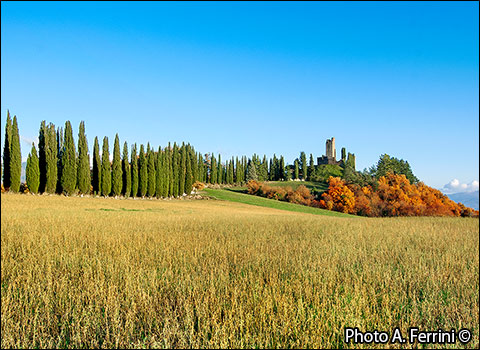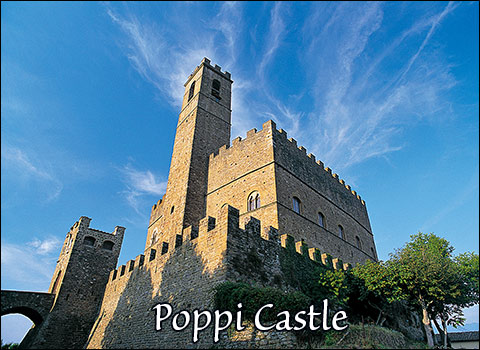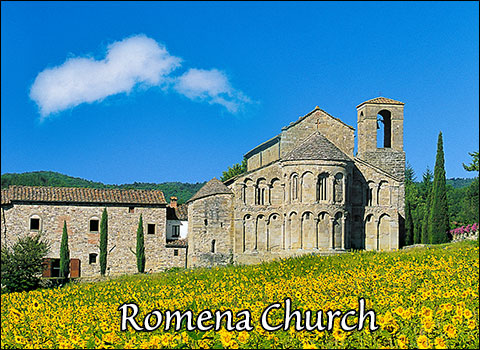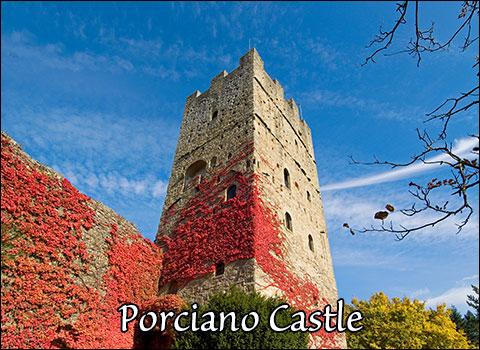Romena Castle, a symbol of the Middle Ages
in Casentino, a Tuscan valley with which you can get familiar in every detail through this site
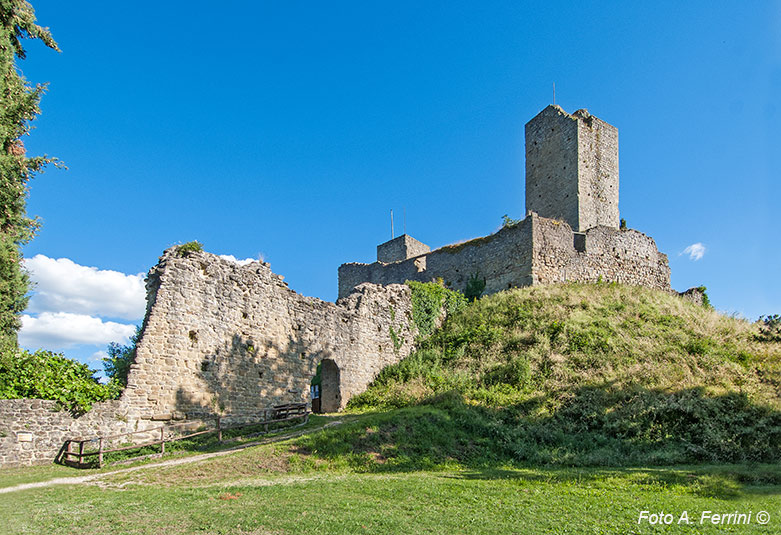
Texts and photos by Alessandro Ferrini ©
30 images in sequence to get to know the Romena Castle and the landscape that surrounds it. Click to enlarge
Romena Castle: a few ruins, an extraordinary charm
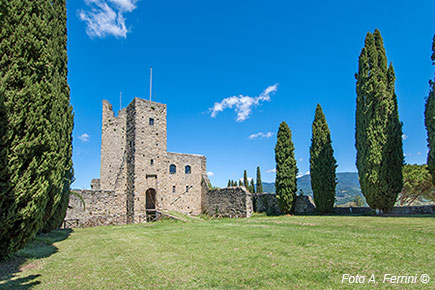 Today, the Romena Castle has an important value not only for its history and architecture, but also for the beauty of the landscape where it is located. The three remaining towers are visible from many parts of the Casentino. It is therefore obvious that a large part of the valley is dominated from the castle. The hill where it is located could be defined as a promontory on the right bank of the Arno, two hundred meters higher than the river (620 meters of altitude). The castle also welcomes the visitor in such a way that he is fascinated even before entering its walls. In fact, the top of the hill shows a great change of colors according to the season. Different emotions it can offer us even in the space of a few hours, depending on the direction of the light that illuminates it. Then, that long avenue accompanied by a double row of centuries-old cypress trees, the last stretch of road leading to the castle, gives the place that image of the typical landscape that has made Tuscany unmistakable in the world. This environment of extraordinary charm cannot fail to have influenced the spirit of two great figures of Italian literature who were guests here six centuries apart: Dante Alighieri, during his exile in the early fourteenth century, and Gabriele D'Annunzio, from June to October 1902. The first mentions Romena and the underlying Fonte Branda in Canto XXX of the Inferno (verses 73-78) when he speaks to us of Adamo il Falsario. The second wrote the third book of Le Laudi in this place.
As for the tourist interest in the Romena Castle, it should be remembered that this can count on another important monument. Not far away, and below this, is the Romanesque church of the same name built in the mid-twelfth century. Declared a National Monument, it is a building of extraordinary architectural beauty. From here, with a walk of about one kilometer uphill on a driveway, it is possible to reach the castle. The route will fully show us the environmental beauties we have described. Halfway along this road we meet a fork on the right. On this road between the fields, after a few meters on the left, is the aforementioned Fonte Branda. The castle is also easily reachable by roads that join the road from Pratovecchio and Stia to the Passo della Consuma road, the historic link between Casentino and Florence. Clearly, coming from this city, a detour to the left at Scarpaccia brings us to the castle in a few minutes. After a few meters of this road it is advisable to stop. We will have a beautiful view of the Casentino valley with Romena in the foreground and Mount La Verna on the horizon (first image in the photo gallery).
The Castle of Romena is commonly considered the oldest in the Casentino. Its history differs from the many other castles present in the upper part of this valley which for over three centuries was dominated by the Guidi. Romena is older than the other castles because it was not founded by this noble family. It is mentioned for the first time in a document of 1008 as a “castrum” belonging to Count Guido Alberto of the Signoria of Spoleto who owned a vast territory in this area. Presumably the construction of a first fortified structure can be traced back to the last decades of the 10th century. The Torre delle Prigioni of the subsequent Castello dei Guidi may have been a previous watchtower built by the Marquises of Spoleto.
Due to a kinship created between the Lords of Spoleto and the Guidi, the latter exercised a certain power over Romena already in the second half of the 11th century. In the first decades of the following century, the Guidi were already masters of the castle, creating a branch of this family called, precisely, Guidi di Romena. They immediately began the renovation of the castle by equipping it with a double wall and they built another castle along the Arno, the current Pratovecchio, where in 1140 they founded the female monastery of San Giovanni Evangelista headed by the Abbess Sofia, a woman of strong character. of their family who, if necessary, "did not hesitate to take up the sword". The Guidi also financed the construction of a large and beautiful church for their people: the Pieve di Romena, mentioned above.
For a century and a half, until the last years of the thirteenth century, the Castle of Romena represented the symbol of the political, economic and military power of the Guidi in Casentino. The double circle of walls, with eleven watchtowers on the outside, made it impregnable. An ancient tradition tells us that he had a secret escape route. From the keep an underground passage led to the monastery of Pratovecchio. Certainly something fascinating, but no trace has ever been found of this structure.
In the last decades of the thirteenth century, with the completion of the Poppi Castle, Romena began to lose importance for the Guidi. Furthermore, the victory of Florence in the Battle of Campaldino, 1289, even though it did not decree the end of the Guidi,
Today, the Romena Castle has an important value not only for its history and architecture, but also for the beauty of the landscape where it is located. The three remaining towers are visible from many parts of the Casentino. It is therefore obvious that a large part of the valley is dominated from the castle. The hill where it is located could be defined as a promontory on the right bank of the Arno, two hundred meters higher than the river (620 meters of altitude). The castle also welcomes the visitor in such a way that he is fascinated even before entering its walls. In fact, the top of the hill shows a great change of colors according to the season. Different emotions it can offer us even in the space of a few hours, depending on the direction of the light that illuminates it. Then, that long avenue accompanied by a double row of centuries-old cypress trees, the last stretch of road leading to the castle, gives the place that image of the typical landscape that has made Tuscany unmistakable in the world. This environment of extraordinary charm cannot fail to have influenced the spirit of two great figures of Italian literature who were guests here six centuries apart: Dante Alighieri, during his exile in the early fourteenth century, and Gabriele D'Annunzio, from June to October 1902. The first mentions Romena and the underlying Fonte Branda in Canto XXX of the Inferno (verses 73-78) when he speaks to us of Adamo il Falsario. The second wrote the third book of Le Laudi in this place.
As for the tourist interest in the Romena Castle, it should be remembered that this can count on another important monument. Not far away, and below this, is the Romanesque church of the same name built in the mid-twelfth century. Declared a National Monument, it is a building of extraordinary architectural beauty. From here, with a walk of about one kilometer uphill on a driveway, it is possible to reach the castle. The route will fully show us the environmental beauties we have described. Halfway along this road we meet a fork on the right. On this road between the fields, after a few meters on the left, is the aforementioned Fonte Branda. The castle is also easily reachable by roads that join the road from Pratovecchio and Stia to the Passo della Consuma road, the historic link between Casentino and Florence. Clearly, coming from this city, a detour to the left at Scarpaccia brings us to the castle in a few minutes. After a few meters of this road it is advisable to stop. We will have a beautiful view of the Casentino valley with Romena in the foreground and Mount La Verna on the horizon (first image in the photo gallery).
The Castle of Romena is commonly considered the oldest in the Casentino. Its history differs from the many other castles present in the upper part of this valley which for over three centuries was dominated by the Guidi. Romena is older than the other castles because it was not founded by this noble family. It is mentioned for the first time in a document of 1008 as a “castrum” belonging to Count Guido Alberto of the Signoria of Spoleto who owned a vast territory in this area. Presumably the construction of a first fortified structure can be traced back to the last decades of the 10th century. The Torre delle Prigioni of the subsequent Castello dei Guidi may have been a previous watchtower built by the Marquises of Spoleto.
Due to a kinship created between the Lords of Spoleto and the Guidi, the latter exercised a certain power over Romena already in the second half of the 11th century. In the first decades of the following century, the Guidi were already masters of the castle, creating a branch of this family called, precisely, Guidi di Romena. They immediately began the renovation of the castle by equipping it with a double wall and they built another castle along the Arno, the current Pratovecchio, where in 1140 they founded the female monastery of San Giovanni Evangelista headed by the Abbess Sofia, a woman of strong character. of their family who, if necessary, "did not hesitate to take up the sword". The Guidi also financed the construction of a large and beautiful church for their people: the Pieve di Romena, mentioned above.
For a century and a half, until the last years of the thirteenth century, the Castle of Romena represented the symbol of the political, economic and military power of the Guidi in Casentino. The double circle of walls, with eleven watchtowers on the outside, made it impregnable. An ancient tradition tells us that he had a secret escape route. From the keep an underground passage led to the monastery of Pratovecchio. Certainly something fascinating, but no trace has ever been found of this structure.
In the last decades of the thirteenth century, with the completion of the Poppi Castle, Romena began to lose importance for the Guidi. Furthermore, the victory of Florence in the Battle of Campaldino, 1289, even though it did not decree the end of the Guidi, 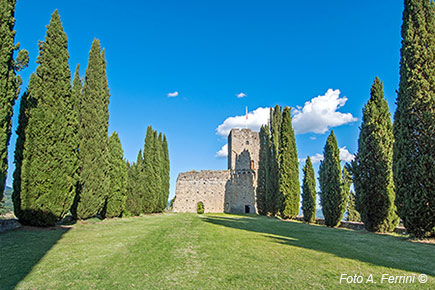 had weakened their power and the incursions into Casentino by the troops of Florence were more and more frequent. In 1357 the Guidi sold the Castle of Romena to the Florentines who carried out its restoration. In 1440 Romena experienced the occupation and damage of the mercenary captain Niccolò Piccinino. Florence soon recovered the castle but left it abandoned because he believed that these fortified structures, now within a vast territory under his dominion, no longer had any use. An inevitable and irreversible decay began for Romena to which two violent earthquakes contributed: 1599 and 1729. The castle also became a convenient stone quarry for the people of the area who wanted to build a house or build the walls of an agricultural terrace. Today, of the outermost walls of the castle only a tower remains which is located near Fonte Branda.
In 1786 the Castle of Romena was purchased by Count Giuseppe Goretti De 'Flamini. It still belongs to its descendants, who have taken care of its conservation over the years.
This is how this place could be presented: a large lawn at the top of a hill surrounded by cypresses, low walls and three ancient towers. All around, the Casentino. It would be normal to think that this castle doesn't have much to show off. Maybe it's true. However, with a little imagination, it will not be difficult to imagine what its grandeur could have been in the Middle Ages and the sensations it will leave us will not make us regret our visit.
For opening hours of the Castle of Romena and booking visits:
Cooperativa Oros. Tel. 3501963285
info@orostoscana.it
had weakened their power and the incursions into Casentino by the troops of Florence were more and more frequent. In 1357 the Guidi sold the Castle of Romena to the Florentines who carried out its restoration. In 1440 Romena experienced the occupation and damage of the mercenary captain Niccolò Piccinino. Florence soon recovered the castle but left it abandoned because he believed that these fortified structures, now within a vast territory under his dominion, no longer had any use. An inevitable and irreversible decay began for Romena to which two violent earthquakes contributed: 1599 and 1729. The castle also became a convenient stone quarry for the people of the area who wanted to build a house or build the walls of an agricultural terrace. Today, of the outermost walls of the castle only a tower remains which is located near Fonte Branda.
In 1786 the Castle of Romena was purchased by Count Giuseppe Goretti De 'Flamini. It still belongs to its descendants, who have taken care of its conservation over the years.
This is how this place could be presented: a large lawn at the top of a hill surrounded by cypresses, low walls and three ancient towers. All around, the Casentino. It would be normal to think that this castle doesn't have much to show off. Maybe it's true. However, with a little imagination, it will not be difficult to imagine what its grandeur could have been in the Middle Ages and the sensations it will leave us will not make us regret our visit.
For opening hours of the Castle of Romena and booking visits:
Cooperativa Oros. Tel. 3501963285
info@orostoscana.it



